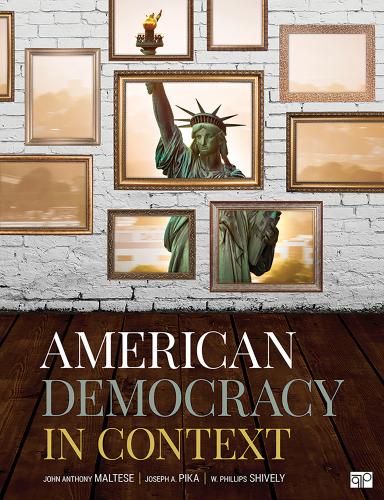Sweden: The line starts at 10%, rises steeply after 1937 to reach 60 in 1980, 65 in 1996, but drops to 50 in 2015.
Note: Government’s expenditures as a percentage of all economic activity grew in all three countries, but less in the United States than in Sweden or Great Britain.
Back to Figure
The horizontal side of the matrix represents “intervention on social issues” and is marked “low” on the left end and “high” on the right end.
The vertical side represents “economic intervention” and is marked “low” at the lower end and “high” at the upper end.
The four cells are labelled as follows.
Top left: Liberal
Top right: Blank
Bottom Left: Libertarian
Bottom right: Conservative
Note: We have divided the grid into four quadrants here for the sake of simplicity. In reality, both dimensions are gradients; one person can be located higher or lower than another or farther left or right, even though both are located in the same quadrant. Each dimension is a matter of degree. Where do you think you would fall on the grid?
Back to Figure
The horizontal axis shows the percent volunteering from 0 to 80.
The details are as follows with all values approximated from the graph.
United Kingdom: 72
Ireland: 70
Netherlands: 68
Canada: 68
Australia: 66
New Zealand: 66
Iceland: 65
Indonesia: 64
United States: 62
Norway: 55
Switzerland: 55
Denmark: 53
Sweden: 52
Israel: 52
Austria: 51
Luxembourg: 50
Italy: 50
Chile: 45
Germany: 43
Finland: 39
Slovenia: 35
Belgium: 35
Slovakia: 34
Japan: 34
South Korea: 34
Poland: 34
Spain: 33
India: 27
Portugal: 27
Brazil: 25
France: 25
Mexico: 24
Czech Republic: 22
Hungary: 21
Argentina: 20
Estonia: 17
Turkey: 15
South Africa: 13
China: 10
Greece: 5
Russia: 5
Note: Sixty-two percent of Americans volunteered time, gave money, or helped strangers in a given month—more than the citizens of many other countries. In general, citizens of prosperous European and North American countries were more generous in this way than citizens of other countries. Why is this so?
2 The Founding and the Constitution
Cindy Hopkins / Alamy Stock Photo
After reading this chapter, you should be able to do the following:
Explain how the American colonies came into being and describe the influence of British tradition on the rights that the colonists came to expect.
Describe the factors that led to the American Revolution and explain how the basic principles of the revolution shaped the governments that followed.
Outline the structure and power of government under the Articles of Confederation and describe the weaknesses that ultimately led to their failure as a form of government.
Describe the delegates to the Constitutional Convention, including the issues that united and divided them and the compromises among them that led to the final document.
Identify the four core principles and major provisions of the U.S. Constitution as well as the ways in which it was undemocratic.
Evaluate the arguments of those on both sides of the ratification battle and the roles of the Federalist Papers and the Bill of Rights in helping to secure ratification.
Describe the formal process of amending the U.S. Constitution as well as the informal process of amendment through interpretation.
Perspective: What Compromises Are Necessary for Ratifying a National Constitution?
It had been a long, hot summer, and the framers of the Constitution were growing weary. The process of drafting a constitution had led to passionate debates about issues ranging from the role of religion in government to how power would be shared between the national and local governments. Since convening in May, the framers had agreed that the national government would consist of three branches: legislative, executive, and judicial. The executive branch would be led by a president. A Supreme Court would enforce the Constitution, and the representative government would be elected by the people. Now, as the end of August approached, the framers remained deadlocked on several key issues. Nevertheless, they were determined to find compromises that would allow them to finish their work and send the Constitution on for ratification. Did this scenario take place in Philadelphia during the summer of 1787? No—Baghdad, summer of 2005.
Indeed, there are some significant similarities between the experiences of the framers in 1787 America and 2005 Iraq. Both were engaged in writing what scholars refer to as “post-conflict constitutions”—that is, constitutions written after winning a struggle for independence or overthrowing an existing government. Both the Constitutional Convention in Philadelphia and the Constitutional Drafting Committee in Baghdad (each with fifty-five delegates) were attempting to solve what appeared to be insoluble political problems. In 1787 Philadelphia, the framers, concerned with the weakness of the central government under the Articles of Confederation, were attempting to create a national government strong enough to ensure compliance with national law at a time when the core principles of the recently fought American Revolution had instilled in the populace a profound distrust of coercive government by distant rulers. How could they create a national government strong enough to keep the nation together but not so strong as to undermine core principles such as liberty or to excessively infringe on the autonomy of states? In 2005 Baghdad, the framers were similarly trying to balance a strong central government with regional autonomy. And both sets of framers consisted of rival factions that disagreed fundamentally about core issues. Could consensus be built under such circumstances?
Consider also the significant differences between 1787 Philadelphia and 2005 Baghdad. For one, the American framers were working in uncharted territory. Individual American states had created constitutions in the wake of the
